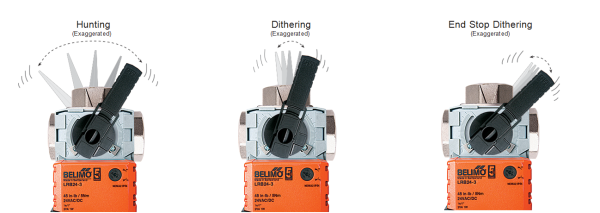Practical Tips to Achieve Excellence in Air and Water Control
When control loops are not properly tuned, actuators may fail prematurely, and the system can provide poor temperature or flow control.
Three conditions are usually caused by poor control loop tuning: oscillation, hunting, and dithering. Oscillation is constant changes in position. Hunting is wide, constant swings in control signal. Dithering is small, sometimes imperceptible changes in signal. For floating actuators, the time and frequency of the pulse, rather than signal voltage, is the control output but the result is the same.
Oscillating control loops caused by being over sensitive can result in more than a million actuator movements in just a few years and can cause actuator failures. In sluggish control loops, actuator movement does not occur or is too small to affect flow, resulting in extreme system overshoot and comfort problems.
There is an easy trade-off between tight control and a reasonable number, and size, of actuator movements. Space temperature changes occur slowly in a stable process. When a room fills with people, it takes about 5 minutes for a 1 degree temperature change to occur. It may take another 5 minutes for a wall sensor to register the change. Fast movements of the actuator are not necessary.
Mixed air control is also a very stable process. Rapid changes in outdoor air temperature or average return air temperatures are rare. On the other hand, discharge air temperature control with a hot water or chilled water valve is a fast process because the sensor is close to the coil. A bare averaging thermistor sensor may respond in 30 seconds to a 1-degree change. Encapsulated sensors may take 2 minutes.
During start-up of a system, more actuator movements may be necessary to find the correct operating condition, but the space is not occupied and there is time to stabilize the system without fast actuator responses. In an ideal control loop, each actuator movement is productive.
Proportional constants (and also integral and derivative) should be set so that continuous oscillation of actuators does not occur. Actuator movement should not occur before the effects of previous movements have had time to affect the sensor. This may be 10 minutes for a space sensor or 1 minute for an air sensor. Movement of damper or valve actuator when air temperature is within .5 degrees of set point, or when mixed-air is within 1 degree of set point usually will yield stable control; attempts to achieve more precise control may result in unstable control and excessive actuator movement.
When 3-point floating control is used, the total run-time of the actuator should be entered into the program logic. When the actuator is at either the fully open or fully closed position, continual pulsing of actuator against end-stops (end-stop dithering) should not occur. The actuator should either stop and hold or drive continuously against the end-stop.
Each VAV box and actuator control loop should be individually tuned. Where high turbulence in the sensor flow control loop is causing dithering (rapid oscillation) of the actuator control loop, the sensor loop should be corrected mechanically or with software averaging. Where the control loop is not fully adjustable, it may be necessary to find a method unique to the individual controller.
If an actuator is “chasing” a process which occurs faster than the actuator movements are able to correct, as may occur in the situation described above, the result will be many more actuator movements than are necessary to affect flow. The average flow should be adjusted, but turbulence is normal and should be ignored.

- Hunting: wide oscillations
- Dithering: small, unproductive movements of the actuator
- End-Stop Dithering: the actuator or damper is at the end of its rotation, but the control loop continues to pulse.
- Reduce the proportional or integral gain.
- Use a deadband.
- Add time delay.
- Reset constants.
- Shut down control when at end-stops.
- Do not control process faster than components response.
